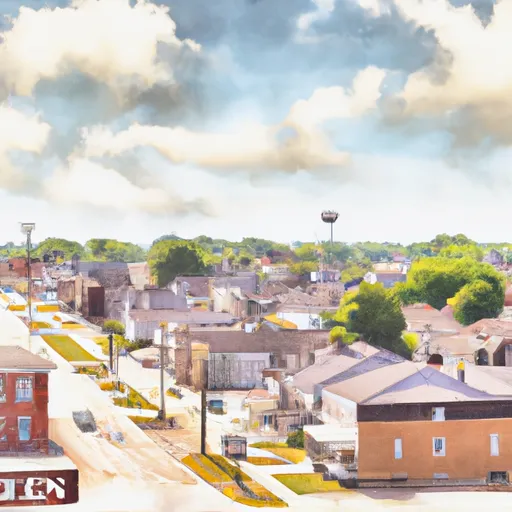-
 Snoflo Premium
Snoflo Premium
Get unlimited access to all our content
With no Ad interruptions! - Start Your Free Trial Login with existing account
Kennard
Eden Index
Climate
7.9
•
Recreation
2.2
•
Community
•
Safeguard
3.9/10

Kennard, Indiana is a small town located in Henry County, in the central part of the state. The climate in Kennard is classified as a humid continental climate, characterized by hot, humid summers and cold winters. Average temperatures range from around 20°F (-7°C) in winter to 85°F (29°C) in summer. Precipitation is evenly distributed throughout the year, with an average annual rainfall of around 40 inches.
Hydrology constituents in Kennard primarily consist of the Big Blue River, which runs through the town. The river offers opportunities for fishing and boating, with species such as bass, catfish, and sunfish present in its waters. There are also several local lakes and ponds that provide additional recreational opportunities for water enthusiasts.
Outdoor recreation is a significant aspect of life in Kennard. The town is surrounded by picturesque countryside, offering opportunities for hiking, biking, and nature exploration. The nearby Westwood Park features well-maintained trails, picnic areas, and playgrounds. Additionally, the area offers opportunities for hunting and birdwatching, with various game species and a diverse bird population.
Overall, Kennard, Indiana provides a pleasant climate, beautiful hydrology constituents, and a range of outdoor recreation opportunities for residents and visitors to enjoy.
What is the Eden Index?
The Snoflo Eden Index serves as a comprehensive rating system for regions, evaluating their desirability through a holistic assessment of climate health, outdoor recreation opportunities, and natural disaster risk, acknowledging the profound impact of these factors on livability and well-being.
Climate Health Indicator (CHI): 7.9
Kennard receives approximately
1101mm of rain per year,
with humidity levels near 83%
and air temperatures averaging around
11°C.
Kennard has a plant hardyness factor of
5, meaning
plants and agriculture in this region thrive during a short period during spring and early summer. Most
plants will die off during the colder winter months.
By considering the ideal temperature range, reliable water supplies, clean air, and stable seasonal rain or snowpacks, the Climate Health Indicator (CHI) underscores the significance of a healthy climate as the foundation for quality living.
A healthy climate is paramount for ensuring a high quality of life and livability in a region, fostering both physical well-being and environmental harmony. This can be characterized by ideal temperatures, reliable access to water supplies, clean air, and consistent seasonal rain or snowpacks.
Weather Forecast
Streamflow Conditions
Patoka-White
Area Rivers
Patoka-White
Snowpack Depths
Patoka-White
Reservoir Storage Capacity
Patoka-White
Groundwater Levels
Recreational Opportunity Index (ROI): 2.2
The Recreational Opportunity Index (ROI) recognizes the value of outdoor recreational options, such as parks, hiking trails, camping sites, and fishing spots, while acknowledging that climate plays a pivotal role in ensuring the comfort and consistency of these experiences.
Access to outdoor recreational opportunities, encompassing activities such as parks, hiking, camping, and fishing, is crucial for overall well-being, and the climate plays a pivotal role in enabling and enhancing these experiences, ensuring that individuals can engage in nature-based activities comfortably and consistently.
Camping Areas
| Campground | Campsites | Reservations | Toilets | Showers | Elevation |
|---|---|---|---|---|---|
| Mt. Etna State Rec Area | None | 819 ft | |||
| My Old Kentucky Home State Park | 40 | 668 ft | |||
| Charlestown State Park | 190 | 616 ft | |||
| Pikes Ridge - Green River Lake | 60 | 890 ft | |||
| Clifty Falls State Park | 165 | 843 ft | |||
| Muscatatuck | 35 | 718 ft | |||
| Lost Bridge State Rec Area - Salamonie Lake | None | 794 ft | |||
| Green River Lake State Park | 160 | 846 ft | |||
| Madison City Park | 35 | 450 ft | |||
| Hardy Lake State Rec Area | 170 | 650 ft |
Nearby Ski Areas
Catastrophe Safeguard Index (CSI):
The Catastrophe Safeguard Index (CSI) recognizes that natural disaster risk, encompassing floods, fires, hurricanes, and tornadoes, can drastically affect safety and the overall appeal of an area.
The level of natural disaster risk in a region significantly affects safety and the overall livability, with climate change amplifying these risks by potentially increasing the frequency and intensity of events like floods, fires, hurricanes, and tornadoes, thereby posing substantial challenges to community resilience and well-being.
Community Resilience Indicator (CRI):
The Community Resilience Indicator (CRI) recognizes that education, healthcare, and socioeconomics are crucial to the well-being of a region. The CRI acknowledges the profound impact of these elements on residents' overall quality of life. By evaluating educational resources, healthcare accessibility, and economic inclusivity, the index captures the essential aspects that contribute to a thriving community, fostering resident satisfaction, equity, and social cohesion.

